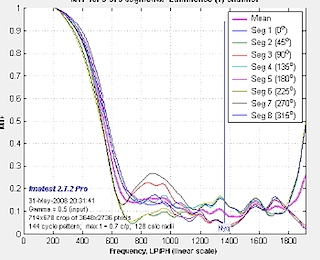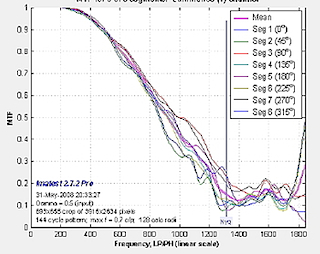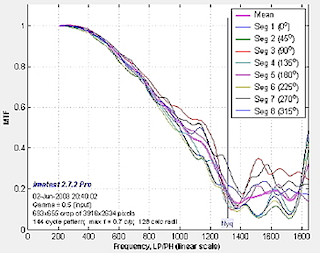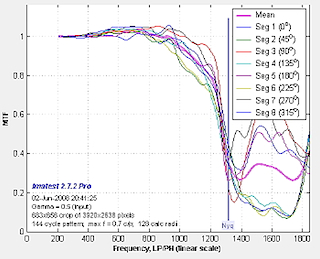Digital machinery and Photographic Image (June, 26, 2008)
Current mainstream views on digital photography all agree that the ‘ digital’ attached to ‘ photography’ implies a change of capture technique and not a paradigm change in the art of photographic or mechanical representation. Photographic cameras are now referred to as solid state cameras (SSC) or digital still cameras (DSC) in the technical literature and DSLR’s in the photographic press. The current DSC models in the classical shape of the single lens reflex camera look and handle like their film-loading predecessors. Image sensors and signal processing are the twin technological pillars of the digital machinery. The analogue with film capture seems evident: film emulsion has been replaced by an image sensor in CCD or CMOS technique and the chemical development of the silver halide grains has been supplanted by signal processing software or image-processing algorithms by image-processing engines.
The final results (the recorded image) may look indistinguishable and may be difficult to tell apart. But that is not the main issue. The real paradigm shift is the fundamental change in actions between the analogue and the digital process. The analogue photographic process has the sequence of Capture-Process-View-Archive. The digital process has the sequence of Capture-View-Process/Archive + Internet.
This is not a simple reversal of actions: it is a true paradigm shift. As with most paradigm shifts, they are not noticed by the persons involved in the change process.
In addition there is the fact that the image at the moment of viewing and processing is in a volatile state: the array of photodiodes contains a spatially sampled version of the scene and this is presented on a monitor and read out serially by a register. At this stage in the workflow the processing of the signals starts and is being influenced by the content of the signal processing software.
This type of processing is not mechanical, as is the case with chemical development. It is already manipulated by human interaction.
The image as recorded and stored when using the film-based techniques is fixed and fully dependent on the physical properties of the lens, the camera and the emulsion. The photographer has the role of operator of apparatus.
The image as captured and stored when using the solid state camera is volatile and fully dependent on the electronic characteristics of the sensor in combination with the quality of the signal processing software.
In the film-based technology the image contrast as measured with the MTF equipment is mainly influenced by the optical properties of the lens and we know that the bandwidth of MTF values depends only on the aperture selected.
MTF values can also be influenced by the signal processing software and now the influence is substantial and operates at every aperture.
Post-processing algorithms are highly effective (even more so than the optical properties of a lens) because the signal processing takes into account the visual characteristics of the human eye.
Where a lens simply records a scene indiscriminately based on the aberration content of the lens, a software algorithm can alter the representation of the scene such that it more pleasing or more arresting for the human eye.
I had the chance recently to use the Olympus E420 camera with the standard zoomlens. The whole package is smaller than an M8 with the Summilux 1.4/50 asph and is so loaded with features and options that you could be mistaken in thinking that this is a professional camera. What I wanted to find out is how this 10 Mp sensor and a humble lens would perform compared to the twelve times more expensive M8 (with f/2.5 Summarit 35mm), also equipped with a 10 Mp sensor.
Below you find the testresults: Olympus at 5.6 and Leica at 5.6. Raw files only adjusted for minimal sharpness (the true raw file of the Olympus is not really sharp). Below: E420, : Down:M8


The result is as can be predicted: The Leica image has more contrast and records much finer details. The Leica images operates close to the Nyquist frequency, fully exploiting the sensor potential, where the Olympus does not perform at the limits.
Given price and target group, there is nothing to lament about. It is more intriguing to remark that the difference is that small.
If we now begin the post processing stage, we can manipulate the files such that the image contrast is boosted to extreme heights, much higher than is possible with the lens alone. See below two examples of what is possible.


Such a boost in contrast inevitably implies a loss of information elsewhere in the image. Clever software does hide this loss such that the sensitivity of the eye does not detect it. For the viewer the camera gives excellent value and the method of creation is not important. We know from the movies and TV series how to manipulate the human eye
In the imaging chain, the role of the lens is becoming less important and the role of the software is now the main engine for image recording and representation.
The Leica M8 is designed and modeled to reflect as many values of the classical M cameras as possible within the digital paradigm. The prime importance of the optical components and the famous handling of the body and its operational controls was integrated with the digital components, but not as fully as with Nikon or Canon cameras. These cameras are sensor- and software driven and show a strong evolutionary path, see the recently announced/rumored D700 and D5 Mark II (or will this be a D7 to counter the Nikon thrust). Most new high-end models feature a sensor with size of the 135mm film format and a pixel count between 12 and 24 M.
The Leica approach for the M-line is based upon very small technological improvements without losing the classical M character. As an aside I quote below a few paragraphs from Charlie Sorrel, who has the following to say about the Leica culture.
Here's an antidote for today's inevitable Apple overdose, and a tale of a fetish older and more noble than the Cult of Mac. This is the Leica M3 Prototype No.0034, one of 65 made in 1952-53.It's a tribute to Leica's engineering skills that this camera is still in "perfect working condition". Or possibly a tribute to the obsessive Leica-philes who keep up their possessions untouched and unused, locked away in a small pit in the basement for years, hidden from human eyes and all the while begging for just a single photon to fall through their beautifully designed light-holes. In the end, though, Stockholm Syndrome sets in, and the little rangefinders come to love their captors, despite living on a subsistence diet of just one roll of Tri-X per year.This particular camera escaped, briefly seeing the light (ƒ1.4 -- lovely bokeh) before being whipped into the basement prison of another collector. The price? Around $38,000. We hope the new owner has time to enjoy his "ceramic pressure plate", "reversed direction rewind knob" and "backdoor with film marker". All whilst wearing latex gloves, of course.
We may sincerely hope that the development of the M-line will not capitalize on these roots as they are far removed from the true intentions of the M3 designers.
Engineering excellence is not a goal in itself that should be admired solely by collectors, but engineering excellence must be useful and valuable in ordinary day tot day work.
There is a tendency now in the Leica world to make a distinction between Leica engineers who are brilliant and Leica managers who are not and this distinction would explain the current state of the affairs at Leica. It is true that Leica managers exhibit a habit of constantly making the wrong decisions, but we should also acknowledge that managers are being advised by engineers and developers who have their own responsibility. It may be true that managers at Leica do not see the necessity of incorporating AF in their cameras because they assume that the Leica clientele does not want this feature. That is a management decision. But if Leica engineers would tell the managers that AF cannot be incorporated into the R-lenses because the heavy mounts do require electric motors that will be too big for the lens, they give an engineering evaluation and it is the responsibility of the development department to present alternative solutions. With the exception of the Correfot (a nice design but impossible to get into production with the required reliability) no engineering solution for the AF problem has been presented by the engineering department. It not as simple and black-white as being presented.
The recent M8 report by Michael Kamber from Iraq seems to question the engineering quality of the M8. His findings are not new: the inaccurate frame lines, the noise at higher ISO speeds, the flawed automatic white balance, the IR problem, ec have all been discussed ad nauseam in the internet and were all mentioned in my reviews. An earlier report form another reporter from Iraq was very positive.
The fact that one camera failed to operate is not nice, but as this is only one instant and have no comparison figures from Leica or other camera models, such an incident is deplorable, but hardly a case for stating that the M8 is not robust or can not be handled in adverse conditions. The basic qualities of the M8 (accurate rangefinder, very small manufacturing tolerances, durable construction, optical excellence, intuitive handling) may not be demanded in the conditions where M. Kamber photographed. He certainly has a point when he comments on the unattended operation of the controls.
That the M8 is not perfect and exhibits some serious flaws is generally acknowledged. The digital capabilities of the M8 are certainly not on the same level as a Nikon or Canon or Pentax or Sony and many digital compacts perform as well or better in this realm.
The Leica M8 in its current state is not the best example of Leica’s engineering genius, but it is a clear statement that Leica wants to emphasize classical values and optical performance in an age where these properties are in danger of becoming footnotes in the relentless shift from mechanics to software superiority.
With this emphasis Leica is also setting the stage for a style of photography that clearly does not rely that heavy on software processing.





